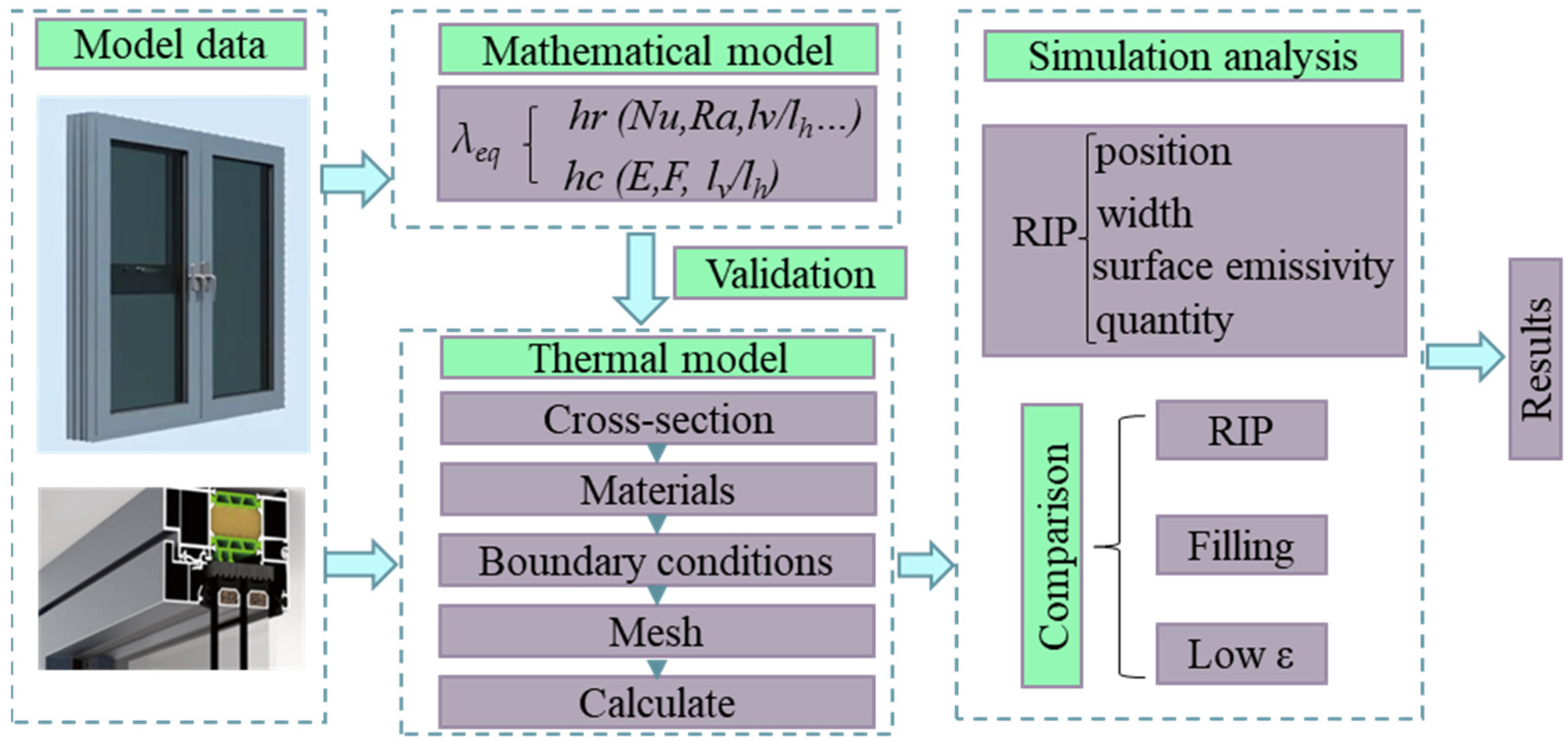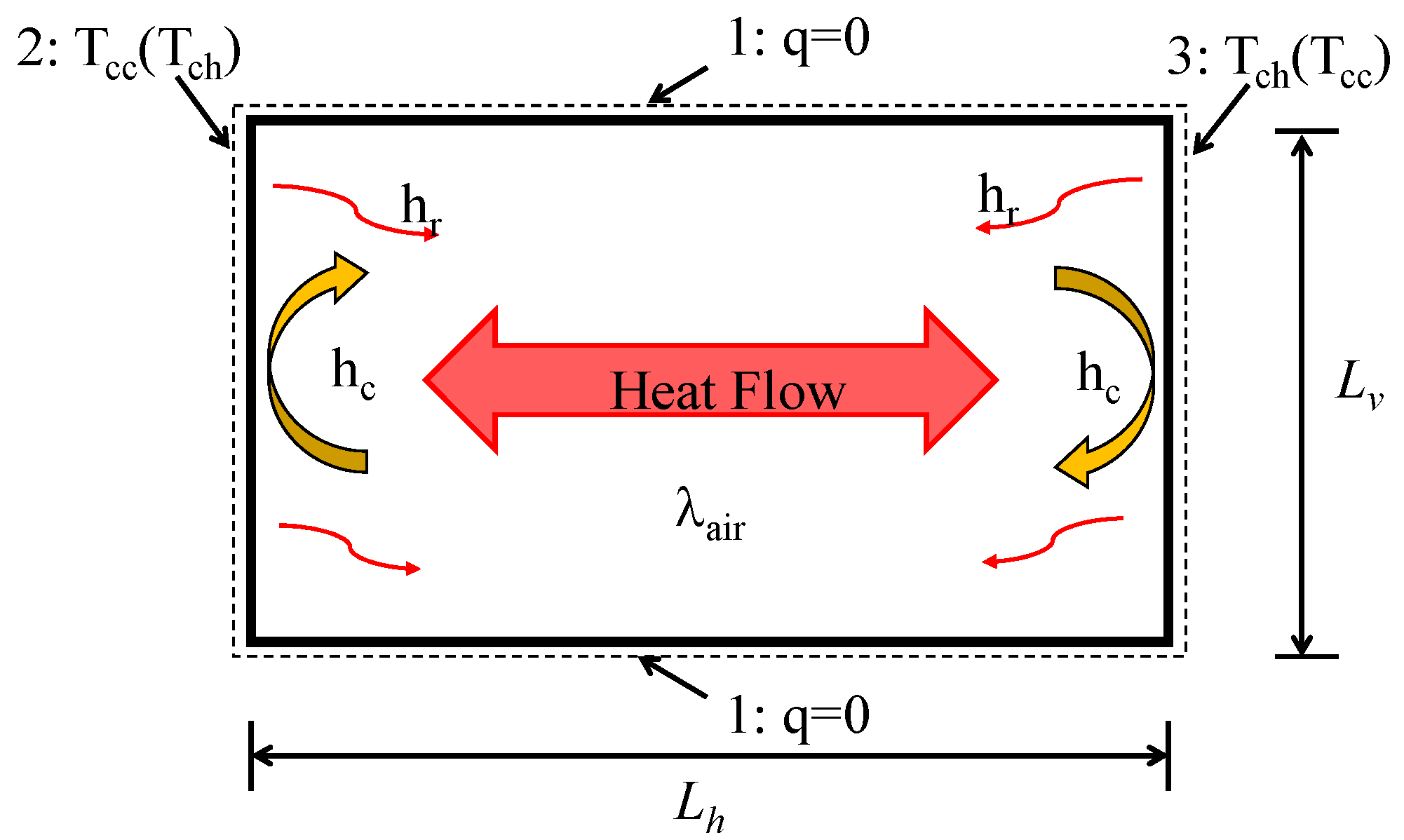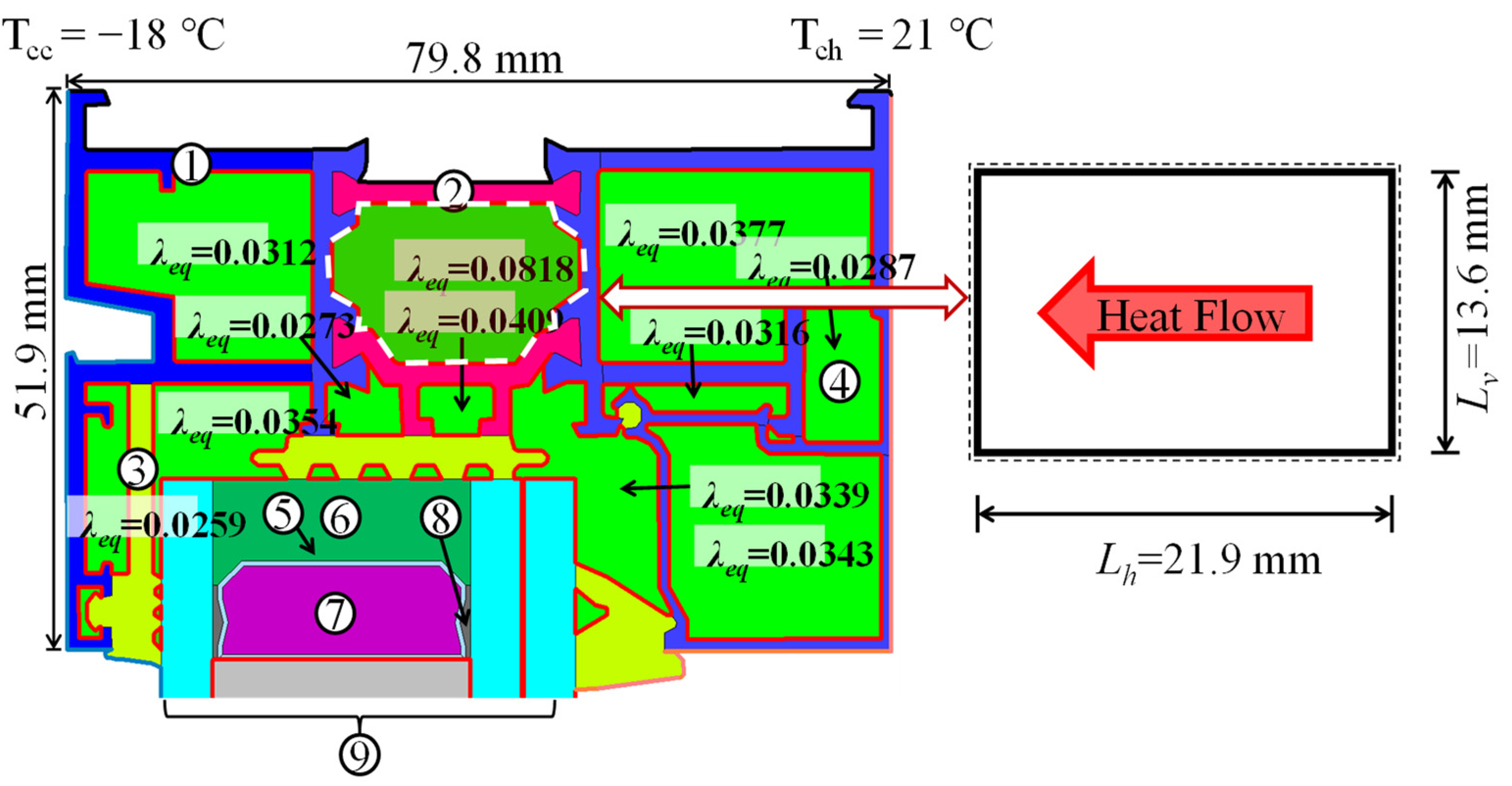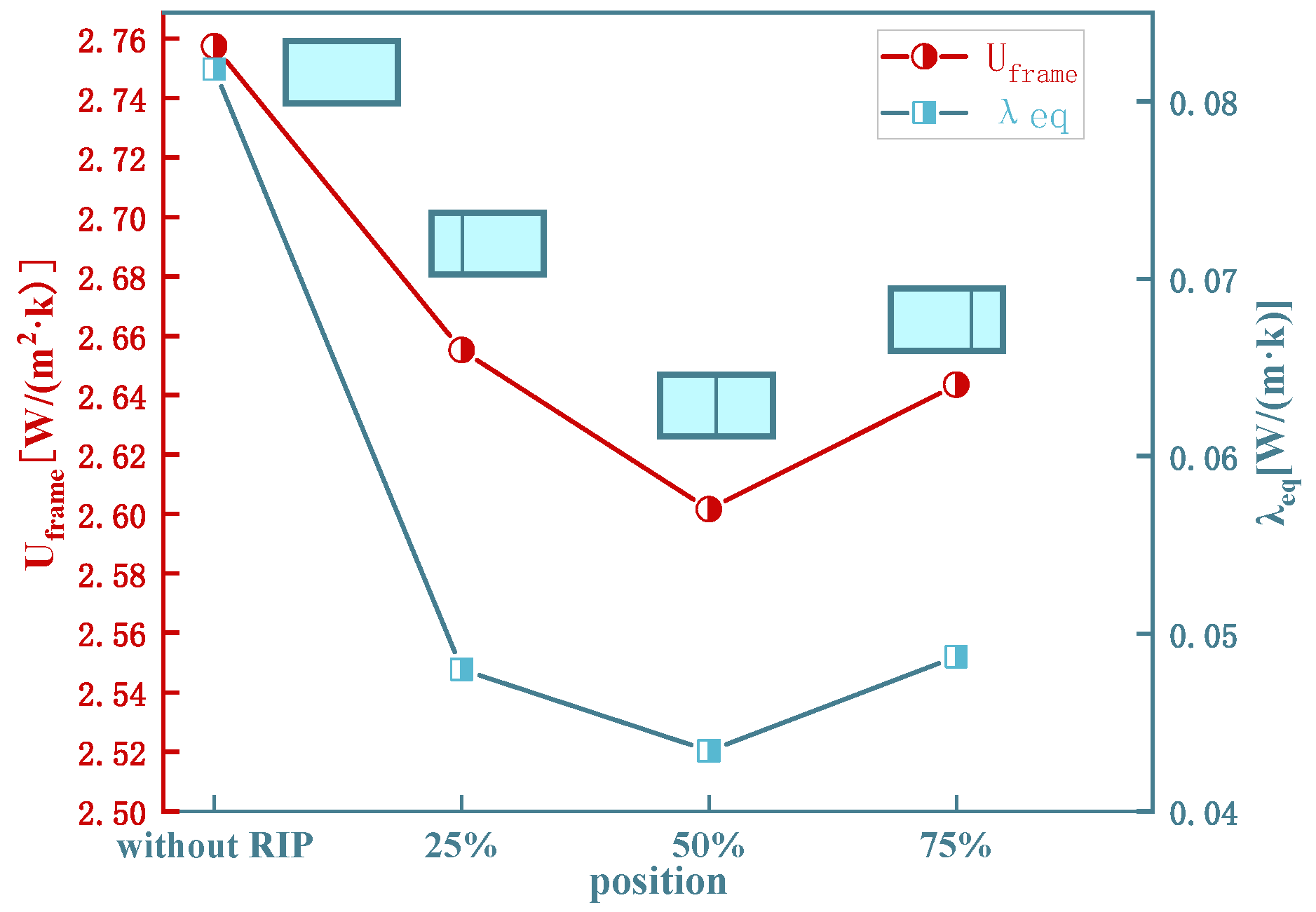Study on the Effect of Radiant Insulation Panel in Cavity on the Thermal Performance of Broken-Bridge Aluminum Window Frame
Abstract
1. Introduction
2. Research Methodology
2.1. Mathematical Model
2.1.1. Convective Heat Transfer Coefficient
- (a)
- For Lv/Lh ≤ 0.5, the Nusselt number is:
- (b) For Lv /Lh≥5, the Nusselt number is:
- (c) For 0.5 < Lv/Lh < 5, the Nusselt number is found using a linear interpolation between the endpoints of (a) and (b) above.
2.1.2. Radiant Heat Transfer
2.1.3. Principle of RIP
2.2. Thermal Model
3. Results
3.1. Analysis of the Influence of the Main Design Parameters of RIP
3.1.1. Position of RIP
3.1.2. Width of RIP
3.1.3. Surface Emissivity of RIP
3.1.4. Quantity of RIP
3.2. Comparative Analysis of Methods to Reduce Heat Transfer in the Cavity
4. Discussions
- The RIP placed in the middle of the cavity can reduce the U-factor of the window frame by 5.56%, which is more conducive to reducing the heat transfer of the window frame.
- The wider the RIP, the greater the U-factor of the window frame, although the U-factor of the window frame increases 0.64% only while the width increases from 0.5 mm to 2.5 mm. The width of the RIP should be as small as possible considering the material cost and the weight of the window frame.
- The smaller the surface emissivity of the RIP, the smaller the U-factor of the window frame. The surface emissivity of the RIP is reduced from 0.9 to 0.1, resulting in a reduction of 2.11%~2.20% of the U-factor. Therefore, the surface emissivity of RIP should be reduced as much as possible.
- The more the amount of RIP, the smaller the U-factor of the window frame. However, increasing the amount of RIP does not have a significant impact on the reduction of the coefficient but increases the cost, while using one RIP can achieve the effect of reducing the U-factor of the window frame by 7.43%. Therefore, it is recommended to use one RIP.
- Compared with the filling and low-emissivity window frames, the U-factor of the RIP type window frame is slightly higher than that of the filling type window frame, but significantly lower than that of the low-emissivity type window frame. The comparison of the RIP type window frame and low-emissivity type window frame shows that the RIP type window frame requires lower surface emissivity of material and functions better than the low-emissivity type window frame. At the same time, the RIP type window frame is less consumable and lighter than the filled type window frame, but the energy-saving effect is comparable to that of the filled type window frame. Filling type and low-emissivity type are more limited by the material, the heat transfer coefficient of the filled material should be lower than the equivalent heat transfer coefficient of the cavity in order to be useful, low-emissivity materials are often expensive, and ultra-low-emissivity materials still need more experimental studies, while RIP type can be made of common materials from a wide range of sources. In summary, the RIP type window frame is a better choice when considering the economy and energy-saving capability simultaneously.
5. Conclusions
Author Contributions
Funding
Data Availability Statement
Conflicts of Interest
Appendix A
| Parameter | Value | Unit |
| d | 0.02186 | m |
| hc | 2.71778 | W/(m2 × K) |
| Nu | 2.50000 | - |
| λai | 0.02377 | W/(m·K) |
| a | 0.00287 | - |
| b | 0.00008 | - |
| Lh | 0.02186 | m |
| Lv | 0.01360 | m |
| Lh/Lv | 1.60731 | - |
| Lv/Lh | 0.62216 | - |
| Nu(Lv/Lh = 0.5) | 2.85571 | - |
| Nu1(Lv/Lh = 5) | 2.09503 | - |
| Nu2(Lv/Lh = 5) | 2.69874 | - |
| Nu3(Lv/Lh = 5) | 1.96587 | - |
| Nu(Lv/Lh = 5) | 2.69874 | - |
| Ra | 34,308.39951 | - |
| ρai | 1.31015 | kg/m3 |
| cp,ai | 1006.05501 | J/(kg·K) |
| a | 1002.73700 | - |
| b | 0.01232 | - |
| Tch | 6.65100 | °C |
| Tcc | −14.48800 | °C |
| μai | 0.00002 | Pa·s |
| a | 0.00000 | - |
| b | 0.00000 | - |
| Tav | −3.91850 | °C |
| g | 9.80000 | m/s2 |
| β | 0.00371 | K−1 |
| hr | 1.02439 | W/(m2·K) |
| εcc | 0.41000 | - |
| εch | 0.43000 | - |
| σ | 0.00000 | W/(m2·K4) |
| λeq | 0.08181 | W/(m·K) |
References
- Wang, F.; Harindintwali, J.D.; Yuan, Z.; Chen, J.M. Technologies and Perspectives for Achieving Carbon Neutrality. Innovation 2021, 2, 100180. [Google Scholar] [CrossRef] [PubMed]
- Al-Sakkaf, A.; Bagchi, A.; Zayed, T. Evaluating Life-Cycle Energy Costs of Heritage Buildings. Buildings 2022, 12, 1271. [Google Scholar] [CrossRef]
- Yang, F.; Yang, B.; Guo, X.Z.; Yang, T.G. Energy-saving doors and windows and current technology research status. New Build. Mater. 2012, 1056, 84–89. [Google Scholar]
- Bienvenido-Huertas, D.; Oliveira, M.; Rubio-Bellido, C.; Marín, D. A Comparative Analysis of the International Regulation of Thermal Properties in Building Envelope. Sustainability 2019, 11, 5574. [Google Scholar] [CrossRef]
- Ke, Y.; Tan, Y.; Feng, C.; Chen, C.; Lu, Q.; Xu, Q.; Wang, T.; Liu, H.; Liu, X.; Peng, J.; et al. Tetra-Fish-Inspired Aesthetic Thermochromic Windows toward Energy-Saving Buildings. Appl. Energy 2022, 315, 119053. [Google Scholar] [CrossRef]
- Uddin, M.M.; Wang, C.; Zhang, C.; Ji, J. Investigating the Energy-Saving Performance of a CdTe-Based Semi-Transparent Photovoltaic Combined Hybrid Vacuum Glazing Window System. Energy 2022, 253, 124019. [Google Scholar] [CrossRef]
- Gustavsen, A.; Jelle, B.P.; Arasteh, D.; Kohler, C. State-of-the-Art Highly Insulating Window Frames—Research and Market Review; SINTEF: Trondheim, Norway, 2007; p. 941673. [Google Scholar]
- Saadatian, S.; Freire, F.; Simões, N. Embodied Impacts of Window Systems: A Comparative Assessment of Framing and Glazing Alternatives. J. Build. Eng. 2021, 35, 102042. [Google Scholar] [CrossRef]
- Lugaresi, F.; Kotsovinos, P.; Lenk, P.; Rein, G. Review of the Mechanical Failure of Non-Combustible Facade Systems in Fire. Constr. Build. Mater. 2022, 361, 129506. [Google Scholar] [CrossRef]
- Zajas, J.; Heiselberg, P. Analysis of energy saving potential and optimization of thermally broken fiberglass window frames. In Proceedings of the Building Simulation 2011 12th Conference of International Building Performance Simulation Association, Sydney, Australia, 14–16 November 2011; p. 8. [Google Scholar]
- Zajas, J.; Heiselberg, P. Parametric Study and Multi Objective Optimization of Window Frame Geometry. Build. Simul. 2014, 7, 579–593. [Google Scholar] [CrossRef]
- Appelfeld, D.; Hansen, C.S.; Svendsen, S. Development of a Slim Window Frame Made of Glass Fibre Reinforced Polyester. Energy Build. 2010, 42, 1918–1925. [Google Scholar] [CrossRef]
- Cardinale, N.; Rospi, G.; Cardinale, T. Numerical and Experimental Thermal Analysis for the Improvement of Various Types of Windows Frames and Rolling-Shutter Boxes. Int. J. Energy Environ. Eng. 2015, 6, 101–110. [Google Scholar] [CrossRef]
- Huijun, M.; Qinglin, M.; Shan, L.; Kai, W.; Peng, R. Influence of Cavities’Interior Surface Emissivity on Thermal Performance of Window Frame and Building Energy Consumption. J. Build. Energy Effic. 2022, 8, 31–37. [Google Scholar]
- Paulos, J.; Berardi, U. Optimizing the Thermal Performance of Window Frames through Aerogel-Enhancements. Appl. Energy 2020, 266, 114776. [Google Scholar] [CrossRef]
- Lechowska, A.A.; Schnotale, J.A.; Baldinelli, G. Window Frame Thermal Transmittance Improvements without Frame Geometry Variations: An Experimentally Validated CFD Analysis. Energy Build. 2017, 145, 188–199. [Google Scholar] [CrossRef]
- Bienvenido-Huertas, D.; Moyano, J.; Marín, D.; Fresco-Contreras, R. Review of in Situ Methods for Assessing the Thermal Transmittance of Walls. Renew. Sustain. Energy Rev. 2019, 102, 356–371. [Google Scholar] [CrossRef]
- Li, Y.; Teramoto, A.; Ohkubo, T.; Sugiyama, A. Estimation of Indoor Temperature Increments in Summers Using Heat-Flow Sensors to Assess the Impact of Roof Slab Insulation Methods. Sustainability 2022, 14, 15127. [Google Scholar] [CrossRef]
- Finlayson, E.; Mitchell, R.; Arasteh, D.; Huizenga, C.; Curcija, D. THERM 2.0: Program Description; Department of Energy: Wahington, DC, USA, 1998; p. 201. [Google Scholar]
- Blanusa, P.; Goss, W.P.; Roth, H.; Weitzmannn, P.; Jensen, C.F.; Svendsen, S.; Elmahdy, H. Comparison between ASHRAE and ISO Thermal Transmittance Calculation Methods. Energy Build. 2007, 39, 374–384. [Google Scholar] [CrossRef]
- Gustavsen, A.; Grynning, S.; Arasteh, D.; Jelle, B.P.; Goudey, H. Key Elements of and Material Performance Targets for Highly Insulating Window Frames. Energy Build. 2011, 43, 2583–2594. [Google Scholar] [CrossRef]
- Gustavsen, A.; Griffith, B.T.; Arasteh, D. Natural Convection Effects in Three-Dimensional Window Frames with Internal Cavities. Trans. Am. Soc. Heat. Refrig. Air Cond. Eng. 2001, 107, 527–537. [Google Scholar]
- ISO 15099-2003; Thermal Performance of Windows, Doors and Shading Devices: Detailed Calculations. International Organization for Standardization: Geneva, Switzerland, 2001.
- ISO 10077-2; Thermal Performance of Windows, Doors and Shutters–Calculation of Thermal Transmittance–Part 2: Numerical Method for Frames. International Organization for Standardization: Geneva, Switzerland, 2003.
- Gustavsen, A.; Arasteh, D.; Kohler, C.; Curcija, D. Two-Dimensional Conduction and CFD Simulations of Heat Transfer in Horizontal Window Frame Cavities. ASHRAE Trans. 2005, 111, 587–598. [Google Scholar]
- Zhang, X.; Ren, Z.; Mei, F. Heat Transfer; China Architecture & Building Press: Beijing, China, 2007. [Google Scholar]
- NFRC 100: 2010; Procedures for Determining Fenestration Product U-Factors. National Fenestration Rating Council: Greenbelt, MA, USA, 2010.










| Name | Material | Thermal Conductivity [W/m·k] | Surface Emissivity | |
|---|---|---|---|---|
| ① | Window Frame | Aluminum alloy | 160 | 0.2 |
| ② | Thermal Break | Polyamide (Nylon) | 0.25 | 0.9 |
| ③ | Sealing Strip | EPDM (Ternary ethylene propylene) | 0.25 | 0.9 |
| ④ | Cavity | Air | - | - |
| ⑤ | - | Stainless Steel | 17 | 0.8 |
| ⑥ | Sealing Strip | Flexible PVC | 0.14 | 0.9 |
| ⑦ | Desiccant | Silicone | 0.03 | 0.9 |
| ⑧ | Sealant | Solid/hot melt isobutylene | 0.24 | 0.9 |
| ⑨ | Glass Systems | - | - | - |
| Parameter | Value |
|---|---|
| Tout | Exterior ambient temperature of −18 °C |
| Tin | Interior ambient temperature of 21 °C |
| V | Wind speed of 5.5 m/s |
| Trm,out | Mean exterior radiation temperature of Tout |
| Trm,in | Mean interior radiation temperature of Tin |
| hcv,out | Exterior surface coefficient of heat transfer of 26 W/m2 °C |
| hcv,in | Interior surface coefficient of heat transfer of 3.29 W/m2 °C |
| Is | Total density of heat flow rate of incident solar radiation of 0 W/m2 |
| Position |  |  |  |  |
|---|---|---|---|---|
| λeql/λeqr [W/(m·k)] | - | 0.0314/0.0556 | 0.0418/0.0416 | 0.0566/0.0335 |
| λ′eq [W/(m·k)] | 0.0818 | 0.0480 | 0.0434 | 0.0487 |
| Uframe [W/(m2·k)] | 2.7575 | 2.6552 | 2.6016 | 2.6435 |
| Width(mm) | 0.5 | 1.0 | 1.5 | 2.0 | 2.5 |
|---|---|---|---|---|---|
| λeql/λeqr [W/(m·k)] | 0.0412/0.0431 | 0.0407/0.0426 | 0.0403/0.0421 | 0.0396/0.0416 | 0.0391/0.041 |
| λ′eq [W/(m·k)] | 0.0431 | 0.0434 | 0.0438 | 0.0441 | 0.0444 |
| Uframe [W/(m2·k)] | 2.5980 | 2.6013 | 2.6051 | 2.6099 | 2.6146 |
| Condition | Cavity Type | Inner Emissivity | Uframe | Relative Error |
|---|---|---|---|---|
| A | - | 0.2 | 2.7575 | - |
| B | Polyurethane foam filling | - | 2.5102 | −8.97% |
| C | Low radiation surface | 0.1 | 2.7425 | −0.54% |
| D | Ultra low radiation surface | 0.05 | 2.7351 | −0.81% |
Disclaimer/Publisher’s Note: The statements, opinions and data contained in all publications are solely those of the individual author(s) and contributor(s) and not of MDPI and/or the editor(s). MDPI and/or the editor(s) disclaim responsibility for any injury to people or property resulting from any ideas, methods, instructions or products referred to in the content. |
© 2022 by the authors. Licensee MDPI, Basel, Switzerland. This article is an open access article distributed under the terms and conditions of the Creative Commons Attribution (CC BY) license (https://creativecommons.org/licenses/by/4.0/).
Share and Cite
Zheng, Y.; Si, P.; Zhang, Y.; Shi, L.; Huang, C.; Huang, D.; Jin, Z. Study on the Effect of Radiant Insulation Panel in Cavity on the Thermal Performance of Broken-Bridge Aluminum Window Frame. Buildings 2023, 13, 58. https://doi.org/10.3390/buildings13010058
Zheng Y, Si P, Zhang Y, Shi L, Huang C, Huang D, Jin Z. Study on the Effect of Radiant Insulation Panel in Cavity on the Thermal Performance of Broken-Bridge Aluminum Window Frame. Buildings. 2023; 13(1):58. https://doi.org/10.3390/buildings13010058
Chicago/Turabian StyleZheng, Yanhong, Pengfei Si, Yin Zhang, Lijun Shi, Changjiajin Huang, Dongsheng Huang, and Zhineng Jin. 2023. "Study on the Effect of Radiant Insulation Panel in Cavity on the Thermal Performance of Broken-Bridge Aluminum Window Frame" Buildings 13, no. 1: 58. https://doi.org/10.3390/buildings13010058
APA StyleZheng, Y., Si, P., Zhang, Y., Shi, L., Huang, C., Huang, D., & Jin, Z. (2023). Study on the Effect of Radiant Insulation Panel in Cavity on the Thermal Performance of Broken-Bridge Aluminum Window Frame. Buildings, 13(1), 58. https://doi.org/10.3390/buildings13010058







